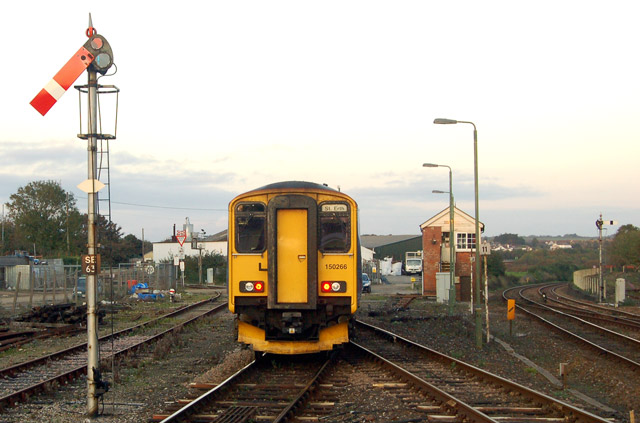St Erth railway station photo-survey (33)
Introduction
The photograph on this page of St Erth railway station photo-survey (33) by Andy F as part of the Geograph project.
The Geograph project started in 2005 with the aim of publishing, organising and preserving representative images for every square kilometre of Great Britain, Ireland and the Isle of Man.
There are currently over 7.5m images from over 14,400 individuals and you can help contribute to the project by visiting https://www.geograph.org.uk

Image: © Andy F Taken: 16 Oct 2009
Class 150 two-car diesel unit number 150266 leaving St Erth on an early evening service to St Ives. Note the semaphore signal lowered to 'clear' to allow the train to proceed (for an explanation see [http://www.geograph.org.uk/photo/1554917] ) and also note the distinctive GWR pattern finial at the top of the signal post. All train movements through the station are controlled from St Erth signal box (see also [http://www.geograph.org.uk/photo/1554897] ) which can be seen beyond the train. The well-maintained St Erth railway station in Cornwall is on the former Great Western Railway (GWR) West of England main line. It is the junction for the St Ives branch line and retains a traditional appearance with its handsome granite buildings, wooden valanced canopies and semaphore signalling. The station is east of the A30 road near Lelant and is over a mile from the village from which it takes its name. The original single-platform station (built by the West Cornwall Railway in 1852) was rebuilt by the GWR after the St Ives branch opened in the 1870s. The mainline was originally single-track but the line was doubled eastwards in 1899 and westwards in 1929. The St Ives branch was built as, and remained, a single-track line. There are three platforms in use at St Erth station. Platform 1 is a facing platform serving the down (westbound) main line. Platform 2 serves the up (eastbound) main line. The two main line platforms can accommodate eight-car trains and are connected by a covered footbridge of GWR vintage (the bridge provides the only access to platform 1). Platform 3 is a terminal bay platform serving the St Ives branch. The west end of platform 2 is a facing platform but the east end forms an island platform (albeit on two levels) with platform 3. There is also a short loading dock on a second track in the St Ives branch bay. Beyond the up (east) end of the station, the St Ives branch curves sharply north and St Erth signal box, which dates from 1899, is situated between the main line and the diverging branch. There is a fan of sidings opposite the signal box on the south side of the main line. St Erth station is managed by First Great Western (FGW) which operates most of the services. The St Ives service is operated as an out-and-back shuttle by FGW (though a few branch trains are extended to and from Penzance). The company also operates local stopping services between Plymouth and Penzance and FGW expresses from London to Penzance stop at St Erth. CrossCountry operates daily services to and from the Midlands, the north and Scotland. South West Trains operates infrequent services to London Waterloo. For pictures of St Erth station in 1979 and 1981 see [http://www.geograph.org.uk/photo/1005319] and [http://www.geograph.org.uk/photo/604669] .

